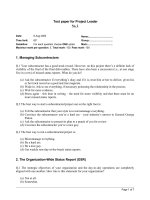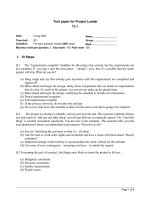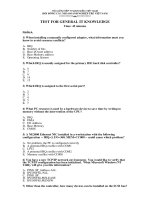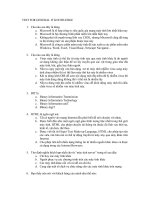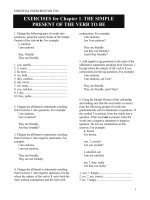Documentation For Emu8086 ASM-EMU86
Bạn đang xem bản rút gọn của tài liệu. Xem và tải ngay bản đầy đủ của tài liệu tại đây (547.45 KB, 101 trang )
ASM86 with The EMU8086
EMU8086 Solutions
To make sure you are using the latest version, choose check for an update from the help
menu.
Windows Vista and Windows 7 users should enable Windows XP compatibly mode. Windows
XP compatibly mode should also be applied to all virtual hardware devices. To further
minimize incompatibly problems, it's recommended to run both the emulator and any
virtual devices as system administrator.
READ/WRITE access is required for these files:
C:\emu8086.io
C:\emu8086.hw
(these files are used to communicate with virtual devices and for emulating hardware
interrupts)
Technical support e-mail:
1
HELP
Documentation for 8086 assembler and emulator
documentation for emu8086 - assembler and microprocessor
emulator
•
Where to start?
•
Assembly Language Tutorials
•
Working with The Editor
•
How to Compile The Code
•
Working with The Emulator
•
Complete 8086 Instruction Set
•
Short List of Supported Interrupt Functions
•
Global Memory Table
•
Custom Memory Map
•
Masm / Tasm compatibility
•
I/O ports and Hardware Interrupts
•
emu8086 official website
•
The Licence Agreement and Terms of Use
•
Frequently Asked Questions
(online)
(online)
The reference and tutorials were once checked and partly re-written by Daniel B.
Sedory (aka The Starman).
to visit The Starman's Realm click here.
•
where to start?
•
tutorials
o
numbering systems
2
•
•
o
part 1: what is assembly language?
o
part 2: memory access
o
part 3: variables
o
part 4: interrupts
o
part 5: library of common functions - emu8086.inc
o
part 6: arithmetic and logic instructions
o
part 7: program flow control
o
part 8: procedures
o
part 9: the stack
o
part 10: macros
o
part 11: making your own operating system
o
part 12: controlling external devices (robot, stepper-motor,
thermometer, traffic lights, printer and led display)
emu8086 reference
o
source code editor
o
compiling assembly code
o
using the emulator
o
complete 8086 instruction set
o
list of supported interrupts
o
global memory table
o
custom memory map
o
masm / tasm compatibility
o
i/o ports and hardware interrupts
complete 8086 instruction set
3
•
download EMU8086 software package
Where to start?
1. Click code examples and select Hello, world. A code example with many
comments should open. All comments are green and they take up about
90% of all text, so don't be scared by this tiny "Hello Word" code. The
compiled executable is only about 100 bytes long, because it uses no
interrupts and has only one loop for color highlighting the text. All other code
is straight-forward and writes directly to video memory.
2. To run this example in the emulator, click emulate (or press F5). The
program then attmepts to assemble and save the executable to
c:\emu8086\MyBuild. If the assembler succeeds in creating the file, the
emulator will also automatically load it into memory.
3. You can then click single step (or press F8) to step through the code one
instruction at a time, observing changes in registers and the emulator
screen. You can also click step back (or press F6) to see what happens
when reversing those changes.
4. There are many ways to print "Hello,World" in assembly language, and this
certainly isn't the shortest way. If you click examples and browse
c:\emu8086\examples, you'll find HelloWorld.asm which assembles into
only a 30-byte executable. Unlike the previous example which carries out
each step by itself, this one is much smaller because it uses a built-in
interrupt function of the operating system to write to the display.
The integrated 8086 assembler can generate console programs that can be
executed on any computer that runs x86 machine code (Intel/AMD architecture)
The architecture of the 8086 Intel microprocessor is called "Von Neumann
architecture" after the mathematician who conceived of the design.
NOTE: A CPU can interpret the contents of memory as either instructions or data;
there's no difference in the individual bytes of memory, only the way in which
they're arranged. Because of this, it's even possible for programs to re-write their
own instructions, then execute the instructions they've changed.
4
EMU8086 Tutorials
8086 assembler tutorials
•
numbering systems
•
part 1: what is assembly language?
•
part 2: memory access
•
part 3: variables
•
part 4: interrupts
•
part 5: library of common functions - emu8086.inc
•
part 6: arithmetic and logic instructions
•
part 7: program flow control
•
part 8: procedures
•
part 9: the stack
•
part 10: macros
•
part 11: making your own operating system
•
part 12: controlling external devices (robot, stepper-motor...)
Numbering systems tutorial
What is it?
There are many ways to represent the same numeric value. Long ago,
humans used sticks to count, and later learned how to draw pictures of sticks
in the ground and eventually on paper. So, the number 5 was first
represented as: | | | | | (for five sticks).
5
Later on, the Romans began using different symbols for multiple numbers of
sticks: | | | still meant three sticks, but a V now meant five sticks,
and an X was used to represent ten of them!
Using sticks to count was a great idea for its time. And using symbols instead
of real sticks was much better.
Decimal System
Most people today use decimal representation to count. In the decimal
system there are 10 digits:
0, 1, 2, 3, 4, 5, 6, 7, 8, 9
These digits can represent any value, for example:
754.
The value is formed by the sum of each digit, multiplied by the base (in this
case it is 10 because there are 10 digits in decimal system) in power of digit
position (counting from zero):
Position of each digit is very important! for example if you place "7" to the
end:
547
it will be another value:
Important note: any number in power of zero is 1, even zero in power of
zero is 1:
6
Binary System
Computers are not as smart as humans are (or not yet), it's easy to make an
electronic machine with two states: on and off, or 1 and 0.
Computers use binary system, binary system uses 2 digits:
0, 1
And thus the base is 2.
Each digit in a binary number is called a BIT, 4 bits form a NIBBLE, 8 bits
form a BYTE, two bytes form a WORD, two words form a DOUBLE WORD
(rarely used):
There is a convention to add "b" in the end of a binary number, this way we
can determine that 101b is a binary number with decimal value of 5.
The binary number 10100101b equals to decimal value of 165:
Hexadecimal System
Hexadecimal System uses 16 digits:
0, 1, 2, 3, 4, 5, 6, 7, 8, 9, A, B, C, D, E, F
And thus the base is 16.
7
Hexadecimal numbers are compact and easy to read.
It is very easy to convert numbers from binary system to hexadecimal
system and vice-versa, every nibble (4 bits) can be converted to a
hexadecimal digit using this table:
Decimal Binary Hexadecimal
(base 10) (base 2) (base 16)
0
0000
0
1
0001
1
2
0010
2
3
0011
3
4
0100
4
5
0101
5
6
0110
6
7
0111
7
8
1000
8
9
1001
9
10
1010
A
11
1011
B
12
1100
C
13
1101
D
14
1110
E
15
1111
F
There is a convention to add "h" in the end of a hexadecimal number, this
way we can determine that 5Fh is a hexadecimal number with decimal value
of 95.
We also add "0" (zero) in the beginning of hexadecimal numbers that begin
with a letter (A..F), for example 0E120h.
The hexadecimal number 1234h is equal to decimal value of 4660:
8
•
Converting from Decimal System to Any Other
In order to convert from decimal system, to any other system, it is required
to divide the decimal value by the base of the desired system, each time you
should remember the result and keep the remainder, the divide process
continues until the result is zero.
The remainders are then used to represent a value in that system.
Let's convert the value of 39 (base 10) to Hexadecimal System (base 16):
As you see we got this hexadecimal number: 27h.
All remainders were below 10 in the above example, so we do not use any
letters.
Here is another more complex example:
let's convert decimal number 43868 to hexadecimal form:
9
The result is 0AB5Ch, we are using the above table to convert remainders
over 9 to corresponding letters.
Using the same principle we can convert to binary form (using 2 as the
divider), or convert to hexadecimal number, and then convert it to binary
number using the above table:
As you see we got this binary number: 1010101101011100b
Signed Numbers
There is no way to say for sure whether the hexadecimal byte 0FFh is
positive or negative, it can represent both decimal value "255" and "- 1".
8 bits can be used to create 256 combinations (including zero), so we simply
presume that first 128 combinations (0..127) will represent positive
numbers and next 128 combinations (128..256) will represent negative
numbers.
In order to get "- 5", we should subtract 5 from the number of combinations
(256), so it we'll get: 256 - 5 = 251.
Using this complex way to represent negative numbers has some meaning, in
math when you add "- 5" to "5" you should get zero.
This is what happens when processor adds two bytes 5 and 251, the result
gets over 255, because of the overflow processor gets zero!
When combinations 128..256 are used the high bit is always 1, so this
10
maybe used to determine the sign of a number.
The same principle is used for words (16 bit values), 16 bits create 65536
combinations, first 32768 combinations (0..32767) are used to represent
positive numbers, and next 32768 combinations (32767..65535) represent
negative numbers.
There are some handy tools in emu8086 to convert numbers, and make
calculations of any numerical expressions, all you need is a click on Math
menu:
Base converter allows you to convert numbers from any system and to any
system. Just type a value in any text-box, and the value will be automatically
converted to all other systems. You can work both with 8 bit and 16 bit
values.
Multi base calculator can be used to make calculations between numbers
in different systems and convert numbers from one system to another. Type
11
an expression and press enter, result will appear in chosen numbering
system. You can work with values up to 32 bits. When Signed is checked
evaluator assumes that all values (except decimal and double words) should
be treated as signed. Double words are always treated as signed values, so
0FFFFFFFFh is converted to -1.
For example you want to calculate: 0FFFFh * 10h + 0FFFFh (maximum
memory location that can be accessed by 8086 CPU). If you check Signed
and Word you will get -17 (because it is evaluated as (-1) * 16 + (-1) . To
make calculation with unsigned values uncheck Signed so that the
evaluation will be 65535 * 16 + 65535 and you should get 1114095.
You can also use the base converter to convert non-decimal digits to signed
decimal values, and do the calculation with decimal values (if it's easier for
you).
These operation are supported:
~
not (inverts all bits).
*
multiply.
/
divide.
%
modulus.
+
sum.
subtract (and unary -).
<< shift left.
>> shift right.
&
bitwise AND.
^
bitwise XOR.
|
bitwise OR.
Binary numbers must have "b" suffix, example:
00011011b
Hexadecimal numbers must have "h" suffix, and start with a zero
when first digit is a letter (A..F), example:
0ABCDh
Octal (base 8) numbers must have "o" suffix, example:
77o
12
8086 assembler tutorial for beginners (part 1)
This tutorial is intended for those who are not familiar with assembler at all, or have
a very distant idea about it. of course if you have knowledge of some other
programming language (basic, c/c++, pascal...) that may help you a lot.
but even if you are familiar with assembler, it is still a good idea to look through
this document in order to study emu8086 syntax.
it is assumed that you have some knowledge about number representation
(hex/bin), if not it is highly recommended to study numbering systems tutorial
before you proceed.
what is assembly language?
assembly language is a low level programming language. you need to get some
knowledge about computer structure in order to understand anything. the simple
computer model as i see it:
the system bus (shown in yellow) connects the various components of a computer.
the CPU is the heart of the computer, most of computations occur inside the CPU.
RAM is a place to where the programs are loaded in order to be executed.
inside the cpu
13
general purpose registers
8086 CPU has 8 general purpose registers, each register has its own name:
•
•
AX - the accumulator register (divided into AH / AL).
BX - the base address register (divided into BH / BL).
•
CX - the count register (divided into CH / CL).
•
DX - the data register (divided into DH / DL).
•
SI - source index register.
•
DI - destination index register.
•
BP - base pointer.
•
SP - stack pointer.
despite the name of a register, it's the programmer who determines the usage for
each general purpose register. the main purpose of a register is to keep a number
(variable). the size of the above registers is 16 bit, it's something like:
0011000000111001b (in binary form), or 12345 in decimal (human) form.
4 general purpose registers (AX, BX, CX, DX) are made of two separate 8 bit
registers, for example if AX= 0011000000111001b, then AH=00110000b and
AL=00111001b. therefore, when you modify any of the 8 bit registers 16 bit
register is also updated, and vice-versa. the same is for other 3 registers, "H" is for
high and "L" is for low part.
14
because registers are located inside the CPU, they are much faster than memory.
Accessing a memory location requires the use of a system bus, so it takes much
longer. Accessing data in a register usually takes no time. therefore, you should try
to keep variables in the registers. register sets are very small and most registers
have special purposes which limit their use as variables, but they are still an
excellent place to store temporary data of calculations.
segment registers
•
•
CS - points at the segment containing the current program.
DS - generally points at segment where variables are defined.
•
ES - extra segment register, it's up to a coder to define its usage.
•
SS - points at the segment containing the stack.
although it is possible to store any data in the segment registers, this is never a
good idea. the segment registers have a very special purpose - pointing at
accessible blocks of memory.
segment registers work together with general purpose register to access any
memory value. For example if we would like to access memory at the physical
address 12345h (hexadecimal), we should set the DS = 1230h and SI = 0045h.
This is good, since this way we can access much more memory than with a single
register that is limited to 16 bit values.
CPU makes a calculation of physical address by multiplying the segment register by
10h and adding general purpose register to it (1230h * 10h + 45h = 12345h):
the address formed with 2 registers is called an effective address.
by default BX, SI and DI registers work with DS segment register;
BP and SP work with SS segment register.
other general purpose registers cannot form an effective address!
also, although BX can form an effective address, BH and BL cannot.
special purpose registers
•
•
IP - the instruction pointer.
flags register - determines the current state of the microprocessor.
IP register always works together with CS segment register and it points to
currently executing instruction.
flags register is modified automatically by CPU after mathematical
15
operations, this allows to determine the type of the result, and to determine
conditions to transfer control to other parts of the program.
generally you cannot access these registers directly, the way you can access
AX and other general registers, but it is possible to change values of system
registers using some tricks that you will learn a little bit later.
8086 assembler tutorial for beginners (part 2)
Memory Access
to access memory we can use these four registers: BX, SI, DI, BP.
combining these registers inside [ ] symbols, we can get different memory
locations. these combinations are supported (addressing modes):
[BX + SI]
[BX + DI]
[BP + SI]
[BP + DI]
[SI]
[DI]
d16 (variable offset only)
[BX]
[BX + SI + d8]
[BX + DI + d8]
[BP + SI + d8]
[BP + DI + d8]
[SI + d8]
[DI + d8]
[BP + d8]
[BX + d8]
[BX + SI + d16]
[BX + DI + d16]
[BP + SI + d16]
[BP + DI + d16]
[SI + d16]
[DI + d16]
[BP + d16]
[BX + d16]
d8 - stays for 8 bit signed immediate displacement (for example: 22, 55h, -1,
etc...)
d16 - stays for 16 bit signed immediate displacement (for example: 300, 5517h,
-259, etc...).
displacement can be a immediate value or offset of a variable, or even both. if
there are several values, assembler evaluates all values and calculates a single
immediate value..
displacement can be inside or outside of the [ ] symbols, assembler generates the
same machine code for both ways.
displacement is a signed value, so it can be both positive or negative.
generally the compiler takes care about difference between d8 and d16, and
generates the required machine code.
16
for example, let's assume that DS = 100, BX = 30, SI = 70.
The following addressing mode: [BX + SI] + 25
is calculated by processor to this physical address: 100 * 16 + 30 + 70 + 25 =
1725.
by default DS segment register is used for all modes except those with BP register,
for these SS segment register is used.
there is an easy way to remember all those possible combinations using this chart:
you can form all valid combinations by taking only one item from each column or
skipping the column by not taking anything from it. as you see BX and BP never go
together. SI and DI also don't go together. here are an examples of a valid
addressing modes:
[BX+5]
,
[BX+SI]
,
[DI+BX-4]
the value in segment register (CS, DS, SS, ES) is called a segment,
and the value in purpose register (BX, SI, DI, BP) is called an offset.
When DS contains value 1234h and SI contains the value 7890h it can be also
recorded as 1234:7890. The physical address will be 1234h * 10h + 7890h =
19BD0h.
if zero is added to a decimal number it is multiplied by 10, however 10h = 16, so if
zero is added to a hexadecimal value, it is multiplied by 16, for example:
7h = 7
70h = 112
in order to say the compiler about data type,
these prefixes should be used:
byte ptr - for byte.
word ptr - for word (two bytes).
for example:
byte ptr [BX]
or
; byte access.
17
word ptr [BX]
; word access.
assembler supports shorter prefixes as well:
b. - for byte ptr
w. - for word ptr
in certain cases the assembler can calculate the data type automatically.
MOV instruction
•
copies the second operand (source) to the first operand (destination).
•
the source operand can be an immediate value, general-purpose register or
memory location.
•
the destination register can be a general-purpose register, or memory
location.
•
both operands must be the same size, which can be a byte or a word.
these types of operands are supported:
MOV REG, memory
MOV memory, REG
MOV REG, REG
MOV memory, immediate
MOV REG, immediate
REG: AX, BX, CX, DX, AH, AL, BL, BH, CH, CL, DH, DL, DI, SI, BP, SP.
memory: [BX], [BX+SI+7], variable, etc...
immediate: 5, -24, 3Fh, 10001101b, etc...
for segment registers only these types of MOV are supported:
MOV SREG, memory
MOV memory, SREG
MOV REG, SREG
MOV SREG, REG
SREG: DS, ES, SS, and only as second operand: CS.
REG: AX, BX, CX, DX, AH, AL, BL, BH, CH, CL, DH, DL, DI, SI, BP, SP.
18
memory: [BX], [BX+SI+7], variable, etc...
The MOV instruction cannot be used to set the value of the CS and IP registers.
here is a short program that demonstrates the use of MOV instruction:
ORG 100h
; this directive required for a simple 1 segment .com program.
MOV AX, 0B800h
; set AX to hexadecimal value of B800h.
MOV DS, AX
; copy value of AX to DS.
MOV CL, 'A'
; set CL to ASCII code of 'A', it is 41h.
MOV CH, 1101_1111b ; set CH to binary value.
MOV BX, 15Eh
; set BX to 15Eh.
MOV [BX], CX
; copy contents of CX to memory at B800:015E
RET
; returns to operating system.
you can copy & paste the above program to emu8086 code editor, and press
[Compile and Emulate] button (or press F5 key on your keyboard).
the emulator window should open with this program loaded, click [Single Step]
button and watch the register values.
how to do copy & paste:
1. select the above text using mouse, click before the text and drag it down
until everything is selected.
2. press Ctrl + C combination to copy.
3. go to emu8086 source editor and press Ctrl + V combination to paste.
as you may guess, ";" is used for comments, anything after ";" symbol is
ignored by compiler.
you should see something like that when program finishes:
19
actually the above program writes directly to video memory, so you may see
that MOV is a very powerful instruction.
8086 assembler tutorial for beginners (part 3)
Variables
Variable is a memory location. For a programmer it is much easier to have some
value be kept in a variable named "var1" then at the address 5A73:235B,
especially when you have 10 or more variables.
Our compiler supports two types of variables: BYTE and WORD.
Syntax for a variable declaration:
name DB value
name DW value
DB - stays for Define Byte.
DW - stays for Define Word.
name - can be any letter or digit combination, though it should start with a letter. It's possible to declare
unnamed variables by not specifying the name (this variable will have an address but no name).
value - can be any numeric value in any supported numbering system (hexadecimal, binary, or decimal), or
"?" symbol for variables that are not initialized.
As you probably know from part 2 of this tutorial, MOV instruction is used to copy
20
values from source to destination.
Let's see another example with MOV instruction:
ORG 100h
MOV AL, var1
MOV BX, var2
RET
; stops the program.
VAR1 DB 7
var2 DW 1234h
Copy the above code to emu8086 source editor, and press F5 key to compile and
load it in the emulator. You should get something like:
As you see this looks a lot like our example, except that variables are replaced with
actual memory locations. When compiler makes machine code, it automatically
replaces all variable names with their offsets. By default segment is loaded in DS
register (when COM files is loaded the value of DS register is set to the same value
as CS register - code segment).
In memory list first row is an offset, second row is a hexadecimal value, third
row is decimal value, and last row is an ASCII character value.
21
Compiler is not case sensitive, so "VAR1" and "var1" refer to the same variable.
The offset of VAR1 is 0108h, and full address is 0B56:0108.
The offset of var2 is 0109h, and full address is 0B56:0109, this variable is a
WORD so it occupies 2 BYTES. It is assumed that low byte is stored at lower
address, so 34h is located before 12h.
You can see that there are some other instructions after the RET instruction, this
happens because disassembler has no idea about where the data starts, it just
processes the values in memory and it understands them as valid 8086 instructions
(we will learn them later).
You can even write the same program using DB directive only:
ORG 100h ; just a directive to make a
simple .com file (expands into no code).
DB 0A0h
DB 08h
DB 01h
DB
DB
DB
DB
8Bh
1Eh
09h
01h
DB 0C3h
DB 7
DB 34h
DB 12h
Copy the above code to emu8086 source editor, and press F5 key to compile and
load it in the emulator. You should get the same disassembled code, and the same
functionality!
As you may guess, the compiler just converts the program source to the set of
bytes, this set is called machine code, processor understands the machine code
and executes it.
ORG 100h is a compiler directive (it tells compiler how to handle the source code).
This directive is very important when you work with variables. It tells compiler that
the executable file will be loaded at the offset of 100h (256 bytes), so compiler
should calculate the correct address for all variables when it replaces the variable
names with their offsets. Directives are never converted to any real machine
22
code.
Why executable file is loaded at offset of 100h? Operating system keeps some
data about the program in the first 256 bytes of the CS (code segment), such as
command line parameters and etc.
Though this is true for COM files only, EXE files are loaded at offset of 0000, and
generally use special segment for variables. Maybe we'll talk more about EXE files
later.
Arrays
Arrays can be seen as chains of variables. A text string is an example of a byte
array, each character is presented as an ASCII code value (0..255).
Here are some array definition examples:
a DB 48h, 65h, 6Ch, 6Ch, 6Fh, 00h
b DB 'Hello', 0
b is an exact copy of the a array, when compiler sees a string inside quotes it
automatically converts it to set of bytes. This chart shows a part of the memory
where these arrays are declared:
You can access the value of any element in array using square brackets, for
example:
MOV AL, a[3]
You can also use any of the memory index registers BX, SI, DI, BP, for
example:
MOV SI, 3
MOV AL, a[SI]
If you need to declare a large array you can use DUP operator.
The syntax for DUP:
number DUP ( value(s) )
number - number of duplicate to make (any constant value).
value - expression that DUP will duplicate.
23
for example:
c DB 5 DUP(9)
is an alternative way of declaring:
c DB 9, 9, 9, 9, 9
one more example:
d DB 5 DUP(1, 2)
is an alternative way of declaring:
d DB 1, 2, 1, 2, 1, 2, 1, 2, 1, 2
Of course, you can use DW instead of DB if it's required to keep values larger
then 255, or smaller then -128. DW cannot be used to declare strings.
Getting the Address of a Variable
There is LEA (Load Effective Address) instruction and alternative OFFSET operator.
Both OFFSET and LEA can be used to get the offset address of the variable.
LEA is more powerful because it also allows you to get the address of an indexed
variables. Getting the address of the variable can be very useful in some situations,
for example when you need to pass parameters to a procedure.
Reminder:
In order to tell the compiler about data type,
these prefixes should be used:
BYTE PTR - for byte.
WORD PTR - for word (two bytes).
For example:
BYTE PTR [BX]
; byte access.
or
WORD PTR [BX]
; word access.
emu8086 supports shorter prefixes as well:
b. - for BYTE PTR
w. - for WORD PTR
in certain cases the assembler can calculate the data type automatically.
Here is first example:
24
ORG 100h
MOV AL, VAR1
to AL.
LEA
MOV
BX, VAR1
; check value of VAR1 by moving it
; get address of VAR1 in BX.
BYTE PTR [BX], 44h
MOV AL, VAR1
to AL.
; modify the contents of VAR1.
; check value of VAR1 by moving it
RET
VAR1 DB 22h
END
Here is another example, that uses OFFSET instead of LEA:
ORG 100h
MOV AL, VAR1
to AL.
; check value of VAR1 by moving it
MOV
BX, OFFSET VAR1
; get address of VAR1 in BX.
MOV
BYTE PTR [BX], 44h
; modify the contents of VAR1.
MOV AL, VAR1
to AL.
; check value of VAR1 by moving it
RET
VAR1 DB 22h
END
Both examples have the same functionality.
These lines:
LEA BX, VAR1
MOV BX, OFFSET VAR1
25
